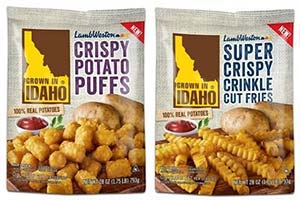Lamb Weston reported impressive results for the first quarter of fiscal 2018 during an earnings call on the morning of October 4. Sales increased 5% to $817 million and income from operations rose 10% to 138 million over the same period in 2017 for the Eagle, Idaho, USA-headquartered producer of frozen potato, appetizer and vegetable products.
“Our strong start to the year reflects a good balance of sales growth, supply chain productivity and cost discipline,” said Tom Werner, president and ceo. “Through our commitment to serving customers and our focus on execution across the company, we continued to drive volume gains, improve price/mix and expand product contribution margins. We expect the operating environment to remain generally favorable during fiscal 2018, with solid demand for frozen potato products globally and tight manufacturing capacity. In the coming months, we expect to start up our new production line in Richland, Washington, which will enable us to continue to support our customers’ growth. As a result, we remain on track to deliver on our full-year targets and are encouraged by our steady progress as an independent company.”
 The Q1 performance beat Wall Street expectations. As this story was being filed several hours following commentary and analysis provided by Werner and CFO Robert McNutt, Lamb Weston stock was trading at $48.18 per share, or +2.14% over the previous day’s closing price. Since the beginning of the year the company’s stock value has advanced approximately 25%.
The Q1 performance beat Wall Street expectations. As this story was being filed several hours following commentary and analysis provided by Werner and CFO Robert McNutt, Lamb Weston stock was trading at $48.18 per share, or +2.14% over the previous day’s closing price. Since the beginning of the year the company’s stock value has advanced approximately 25%.
Optimistic About Fall Crop
Potato raw material prices are always a big factor in the cost of doing business for one of the world’s biggest french fry suppliers, and last year’s disappointing harvest in Europe certainly impacted activities of the company’s Lamb Weston/Meijer operations in the Netherlands. Nonetheless, customer requirements were met.
While the quantity and quality of this fall’s potato crop harvests in North America and Europe won’t be known for the next 30 to 60 days, Werner expressed confidence that yields will meet expectations.
“I think that the crop is at historic levels, or at planned levels,” said the chief executive, though that it’s still too early to tell how harvested potatoes “will perform in plants and store in warehouses.”
He added: “We’re in line with expectations and pretty well on plan. Actually, we’re modestly above plan.”
Q1 Performance Review
In Q1 2018 the price/mix increased 3% over the prior year period due to pricing actions and favorable product and customer mix. Volume increased 2%, with growth seen across all business segments.
Operational income included $2.2 million of costs related to the spinoff from Conga Brands, Inc. (formerly ConAgra Foods, Inc.). A portion of the 10% increase to $137.6 million reflects the impact of $9.7 million of expenses incurred in the prior year period related to the spinoff from Conagra. Excluding these comparability items, income from operations grew $5.1 million, driven by favorable price/mix and higher volume, partially offset by cost inflation, as well as higher selling, general and administrative expense associated with incremental costs for being a stand-alone public company.
 Adjusted EBITDA including unconsolidated joint ventures was $191.4 million, up 11% versus the prior year, reflecting higher equity method investment earnings as well as growth in income from operations.
Adjusted EBITDA including unconsolidated joint ventures was $191.4 million, up 11% versus the prior year, reflecting higher equity method investment earnings as well as growth in income from operations.
Diluted earnings per share (EPS) rose to $0.56 from $0.54 in the prior year period. The increase was primarily driven by growth in income from operations, higher equity method investment earnings and lower income tax expense. The advance was partially offset by higher interest costs related to debt incurred in connection with the spinoff from Conagra.
Adjusted Diluted EPS was $0.57, down from $0.58 in the prior year period. The modest decline was primarily driven by higher interest costs and selling, general and administrative expenses, which were largely offset by higher gross profit, higher equity method investment earnings and lower income tax expense.
The effective tax rate was 33% in the first quarter of fiscal 2018, versus 38% in the prior year period.
Global Segment Sales Up 4%
Net sales for the Global segment, which accounts for a bit more than half of total sales and is driven by the top 100 North America-based restaurant chain customers as well as the company’s international business, increased 4% to $413.9 million. Price/mix increased 3%, largely reflecting price increases and improvement in customer and product mix. Volume increased 1%, driven by domestic market growth.
The Global segment’s product contribution margin increased 1% to $74.7 million, with favorable price/mix and volume gains largely offset by commodity, manufacturing, transportation and warehousing net sales for the Foodservice segment, which services North American foodservice distributors and restaurant chains outside the top 100 North America-based restaurant chain customers, increased 7% to $279.4 million. Price/mix increased 6%, reflecting the carryover effect of pricing actions taken in fiscal year 2017, pricing actions implemented in the current quarter, and improvement in customer and product mix. Volume increased 1%, driven by broad-based growth across the segment’s customer base.
The product contribution margin of Foodservice sales, a segment that accounts for about one third of total revenues, increased 14% to $90.9 million, primarily driven by favorable price/mix, partially offset by commodity, manufacturing, transportation and warehousing cost inflation.
3% Retail Sales Growth
 Net revenues realized in the Retail segment, which includes sales of branded and private label products to grocery, mass merchant and club customers in North America, increased 3% to $92.0 million. Volume advanced 9%, primarily driven by the introduction of Grown in Idaho branded products as well as growth of private label items. Price/mix declined 6%, largely due to higher trade spending in support of the Grown in Idaho campaign.
Net revenues realized in the Retail segment, which includes sales of branded and private label products to grocery, mass merchant and club customers in North America, increased 3% to $92.0 million. Volume advanced 9%, primarily driven by the introduction of Grown in Idaho branded products as well as growth of private label items. Price/mix declined 6%, largely due to higher trade spending in support of the Grown in Idaho campaign.
The Retail segment’s product contribution margin declined 16% to $16.5 million, mainly due to higher trade spending as well as transportation and warehousing cost inflation.
Joint Ventures
Equity method investment earnings from unconsolidated joint ventures were $20 million, an increase of $9.4 million from the prior year period, as favorable price/mix and cost savings initiatives more than offset the impacts of higher raw potato costs in Europe. In addition, this increase includes a $3.4 million unrealized gain related to mark-to-market adjustments associated with currency hedging contracts.
Outlook
Looking ahead, CEO Werner said that Lamb Weston is “extremely optimistic” about global business prospects, especially since a number of key customers are expanding operations. He also noted that the development of a new coated fry product for a major client is on track, with its introduction to the market scheduled for next year.
Meanwhile, the company continues to expect that net sales will grow at a low-to-mid single digit rate, with price/mix and volume growth improving in the second half of fiscal 2018 as new pricing structures for an increasing number of customer contracts become effective and an additional 300 million pounds of annual french fry capacity becomes available from the new line in Washington.
Approximately 75% of the contracts have already been renewed, said Werner, with the remaining 25% expected to be finalized within the next few months.
Adjusted EBITDA including unconsolidated joint ventures should be in the range of $740 million to $760 million, including higher selling, general and administrative expenses as a percentage of sales due to the full-year impact of incremental costs associated with being a stand-alone public company, as well as higher advertising and promotional expense in support of the introduction of the company’s Grown in Idaho product line in retail. Using the mid-point of the range, this represents an increase of approximately 8% versus a fiscal 2017 pro forma Adjusted EBITDA, including unconsolidated joint ventures of $692 million.





